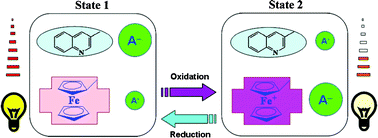Researchers from the Lanzhou Institute of Chemical Physics and Northwest University have successfully employed two tripodal tris(urea) anion receptors with similar structure but different signaling units to control and detect intermolecular anion transfer via an electrolytic stimulus. This molecular motion is based on hydrogen bonding versus hydrogen bonding plus electrostatic interactions. The similar backbone of the two receptors may exclude the interference of different structures, and the results demonstrate that redox-switchable ferrocene groups may be attractive candidates in molecular motion devices.
A molecular-level machine can be defined as an assembly of a discrete number of molecular components designed to perform mechanical-like movements (outputs) as a consequence of appropriate external stimuli (inputs). In such processes energy inputs, such as chemical energy, electrical energy (redox systems), or light, have to be supplied to make the machine work. Great progress has been achieved in this field during the last decades; however, most of the involved components focus on cations (metal ions and H+) and organic molecules, whereas research on anions in the area of molecular machines has been relatively limited.
Anion coordination has become an area of significant importance because anions exist extensively in nature and play ubiquitous roles in environmental, life and medical sciences. In recent years, anion-directed assembly of different supramolecular structures has attracted much attention.
Redox systems have the ability to adjust host–guest interactions upon electrochemical switching. The ferrocene group has been widely used as an electron probe due to its special properties like reversible electron transfer, thermal stability, aromaticity etc., but such groups have not been commonly utilized in molecular machinery.
The work has received support from the National Natural Science Foundation of China. The findings have been published in Org. Biomol. Chem. (Org. Biomol. Chem., 2011, 9, 5637–5640).
Org. Biomol. Chem. Paper


